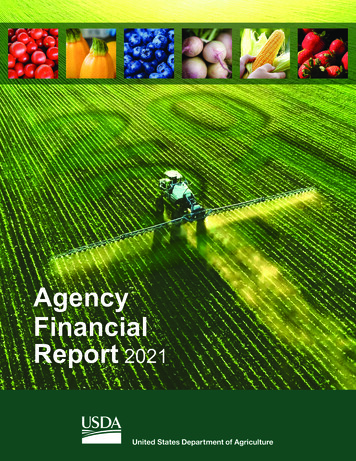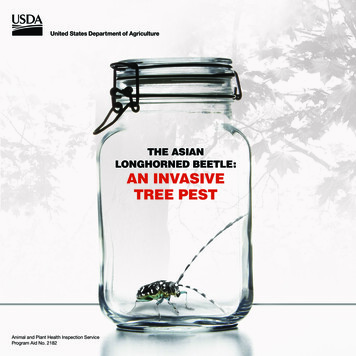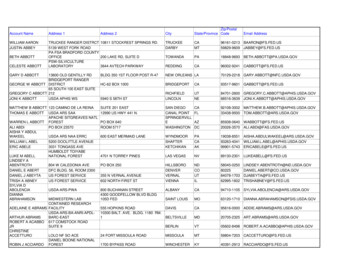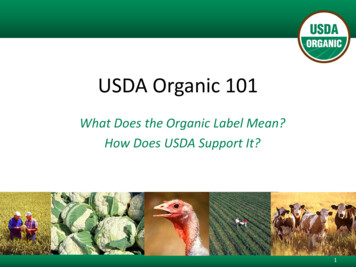
Transcription
AgencyFinancialReport 2021
Page Intentionally Blank
USDA’sNon-Discrimination StatementIn accordance with Federal civil rights law and U.S. Department of Agriculture (USDA) civilrights regulations and policies, USDA, its Mission Areas, agencies, staff offices, employees, andinstitutions participating in or administering USDA programs are prohibited from discriminatingbased on race, color, national origin, religion, sex, gender identity (including gender expression),sexual orientation, disability, age, marital status, family/parental status, income derived from apublic assistance program, political beliefs, or reprisal or retaliation for prior civil rights activity,in any program or activity conducted or funded by USDA (not all bases apply to all programs).Remedies and complaint filing deadlines vary by program or incident.Program information may be made available in languages other than English. Persons withdisabilities who require alternative means of communication to obtain program information(e.g., Braille, large print, audiotape, or American Sign Language) should contact the responsibleMission Area, agency, or staff office; the USDA TARGET Center at (202) 720-2600 (voice andTTY); or the Federal Relay Service at (800) 877-8339.To file a program discrimination complaint, a complainant should complete a Form AD 3027,USDA Program Discrimination Complaint Form, which can be obtained online, from any USDAoffice, by calling (866) 632-9992, or by writing a letter addressed to USDA. The letter mustcontain the complainant’s name, address, telephone number, and a written description of thealleged discriminatory action in sufficient detail to inform the Assistant Secretary for CivilRights about the nature and date of an alleged civil rights violation. The completed AD 3027form or letter must be signed and submitted to USDA by:(1) Mail:U.S. Department of AgricultureExecutive DirectorOffice of the Assistant Secretary for Civil RightsCenter for Civil Rights Enforcement1400 Independence Avenue, SWMail Stop 9430Washington, D.C. 20250-9410(2) Efax:(833) 256-1665(3) Email:ProgramComplaints@usda.govPlease attach a signed AD-3027 complaintform or letter to the email.USDA 2021 Agency Financial Reporti
Page Intentionally Blank
Table of ContentsMessage from Secretary Vilsack . 1Section I Management’s Discussion and Analysis . 5USDA Organization Chart . 6USDA Mission Areas and Staff Offices . 7USDA Program Performance . 10Future Demands, Risks, Uncertainties, Events, Conditions, and Trends . 34Analysis of Financial Statements and Stewardship Information. 36Statement of Assurance . 46Federal Managers’ Financial Integrity Act Report on Management Control . 47Compliance with Laws and Regulations . 53Federal Financial Management Improvement Act Report onFinancial Management Systems . 55Financial Management Systems Strategy . 57Section II Financial Information . 65Message from the Office of the Chief Financial Officer . 65Independent Auditors Report. 68Agency Response to Auditors Report . 80Financial Statements . 81Notes to the Financial Statements . 86Required Supplementary Information . 170Section III Other Information . 177USDA Management Challenges . 177Summary of Financial Statement Audit and Management Assurances. 178Payment Integrity Information Act of 2019 –Improper Payments Overview Payment Integrity. 180Civil Monetary Penalties . 181Grants Program . 199Abbreviations–Acronyms . 201USDA 2021 Agency Financial Reportiii
Page Intentionally BlankivTable of Contents
Message fromSecretary VilsackThe U.S. Department of Agriculture (USDA or the Department)respectfully submits the fiscal year (FY) 2021 Agency Financial Report,fulfilling our responsibility to the American people, President Biden, andthe U.S. Congress.It is a pleasure to be back at USDA with the opportunity to serve theAmerican people as Secretary. This Department touches the lives of allAmericans each day in so many positive ways. I am grateful for thechance to once again work in partnership with the tens of thousands ofdedicated public servants in USDA to bring meaningful change and improve the lives of allAmericans through the Department’s programs and services.As we confront many historical challenges associated with a continuing global pandemic, we arealso presented with even greater opportunities to deliver fundamental services to the Americanpeople in this pivotal time. We will build back better, stronger, and more resilient and equitablethan ever before, and we will do so by recovering from the pandemic, reducing hunger and foodinsecurity, working to ensure racial justice and equity, building up rural America’s economy, andaddressing climate change.In 2021, USDA began that work to build back better than before.The COVID-19 pandemic led to massive disruption for growers and food workers and exposed afood system that was rigid, consolidated, and fragile. To aid in the recovery from the COVID-19pandemic, USDA launched Pandemic Assistance for Producers. While USDA has long provideda safety net to ensure producers can survive an unprofitable year, this time, we set out with themission of reaching a broader set of producers than in previous COVID-19 aid programs.USDA dedicated approximately 6 billion toward new programs to put a greater emphasis onoutreach to small and socially disadvantaged producers, specialty crop and organic producers,timber harvesters, and support for the food supply chain and producers of renewable energy,among others.Through the American Rescue Plan, USDA delivered nutrition assistance to millions of adultsand children. We provided access to the Pandemic Electronic Benefit Transfer program for theduration of the health emergency, including through the summer, to allow families with childrenreceiving school meals to more easily purchase healthy food during the pandemic. We alsoUSDA 2021 Agency Financial Report1
extended a 15 percent increase in Supplemental Nutrition Assistance Program benefits for allparticipants through September 30, 2021; provided 880 million to expand access to fruits andvegetables for mothers and infants, and made investments in innovation to the SpecialSupplemental Nutrition Program for Women, Infants, and Children; invested 37 million forsenior nutrition through the Commodity Supplemental Food Program; and invested 1 billion innutrition assistance for the territories.Through the American Rescue Plan and the Consolidated Appropriations Act, USDA announcedan investment of up to 1 billion in Emergency Food Assistance to serve as a bridge frompandemic assistance to food system transformation. The funding is focused on supporting andexpanding the emergency food network so states, food banks, and local organizations canreliably serve their communities and reach rural, remote, and underserved communities.In addition to providing assistance to resolve lingering challenges directly associated with theCOVID-19 pandemic, USDA is making a major commitment to rebuild our food system as weBuild Back Better. In FY 2021, through the Build Back Better initiative, USDA began investingmore than 4 billion to strengthen and transform the food system in four major areas: (1) foodproduction, (2) food processing, (3) food distribution and aggregation, and (4) markets andconsumers. The Build Back Better initiative will make meaningful investments to build a foodsystem that is more resilient against shocks, delivers greater value to growers and workers, andoffers consumers an affordable selection of healthy food that is produced and sourced locally andregionally by farmers and processors from diverse backgrounds.As part of the Build Back Better initiative, we announced the investment of 500 million inexpanding meat and poultry processing capacity. We also announced more than 150 million forexisting small and very small processing facilities to help them weather COVID, compete in themarketplace, and have the support needed to reach more customers. These investments will addresilience to our food supply chain and level the playing field for farmers and ranchers.Rural American communities were hit hard during the pandemic. Through the American RescuePlan, USDA is implementing funding to invest in the people of rural America. We are investing 100 million through September 2022 in rental assistance for low-income and elderly borrowersand an additional 39 million through September 2023 to help refinance direct loans under theSingle-Family Housing Loan Program and the Single-Family Housing Repair Loans and Grants.We also made available up to 500 million in grants to help rural health care, Tribes, andcommunities expand access to COVID-19 vaccines, health care services, and nutrition assistance.At USDA, we are recommitting ourselves to the values of equity and inclusion rooted in justiceand equal opportunity for our employees and those we serve. This policy includes recognizingopportunities within the Department that ensure historically underserved groups more fullyaccess and participate in USDA programs and services.2Message from the Secretary
To advance this work, in FY 2021, USDA made available 2 million to establish cooperativeagreements to provide outreach and technical assistance to historically underserved farmers andranchers through the Pandemic Assistance for Producers initiative.In accordance with fulfilling provisions included in the bipartisan 2018 Farm Bill, USDAestablished the Heirs’ Property Relending Program, making available 67 million in competitiveloans. By gaining legal title to the land, heirs will gain access to a wide range of governmentassistance. USDA also awarded 21.8 million to the 1890 Land-Grant Institutions NationalProgram to support research at Historically Black Colleges and Universities. The awards willsupport 58 projects at Historically Black Colleges and Universities to strengthen research,extension, and teaching in the food and agricultural sciences.USDA launched our first-ever USDA Racial Justice and Equity Working Group to identify gapsand inadequacies in USDA systems and processes. The Working Group is assessing how USDAcollects and uses data, as well as a broader holistic assessment of equity across USDA programsand services, including procurement, policy, and regulatory actions; how resources are used inservice of equity and civil rights; and how and where the Department conducts stakeholderoutreach. USDA is currently creating the Equity Commission in accordance with the FederalAdvisory Committee Act. Since January, USDA staff have also worked across Mission Areas,Agencies, and Offices to advance the goals of various equity-related executive orders,reinforcing messages, and sharing learnings and best practices.USDA is engaged in a whole-of-government effort to combat the climate crisis and conserve andprotect our Nation’s lands, biodiversity, and natural resources, including our soil, air, and water.We are committed to being a partner to build more resilient communities and putting the UnitedStates in a leadership position on climate change mitigation.As co-lead of the Biden-Harris Administration’s Interagency Drought Relief Working Group, inconjunction with the U.S. Department of the Interior, USDA and our partners are dedicated toaddressing worsening drought conditions in the West and supporting farmers, Tribes, andcommunities impacted by ongoing water shortages. In addition, USDA is the permanent chair ofthe National Drought Resilience Partnership, providing another opportunity to develop long-termmeasures to respond to climate change, build more resilient communities, and protect thenatural environment.As we look to solutions to develop a climate-smart agriculture and forestry strategy, USDA hasadapted some of our programs to provide immediate relief for climate-impacted producers.We invested 25 million for new pilots to assist agricultural producers impacted by worseningdrought conditions. USDA’s Natural Resource Conservation Services is offering 41.8 millionthrough the Environmental Quality Incentives Program to help agricultural producers in Arizona,California, Colorado, and Oregon recover from the impacts of drought and build resiliency.USDA 2021 Agency Financial Report3
In FY 2021, USDA reached out to the public and asked for valuable input on a climate-smartagriculture and forestry strategy. Additionally, we invested 330 million in 85 locally driven,public-private partnerships to mitigate climate change and address other natural resourcechallenges through the Regional Conservation Partnership Program; allocated up to 25 millionfor On-Farm Conservation Innovation Trials in 2021; allocated up to 15 million to support thedevelopment of new tools, approaches, practices, and technologies to further natural resourceconservation on private lands through the Conservation Innovation Grants program; andallocated 10 million to support climate-smart agriculture and forestry through voluntaryconservation practices in 10 targeted states.Each year brings unique challenges, and I am truly proud of the many ways USDA employeesacross the Nation have stepped up during 2021. They have continued to get the job done onbehalf of Americans and support and grow our economy while strengthening rural communities.I know that together, we can continue to deliver efficient service while finding more ways toserve as efficient stewards of taxpayer dollars.Thank you for your interest in the Department.Thomas J. VilsackSecretary of AgricultureNovember 12, 20214Message from the Secretary
Section IManagement’sDiscussion and AnalysisUSDA 2021 Agency Financial Report5
USDA Organization ChartSECRETARYDeputy SecretaryAssistant Secretary forCivil RightsInspectorGeneralOfficeof the ffice of theExecutiveSecretariatOffice ofBudget andProgramAnalysisOffice ofCommunicationsAssistant Secretary forCongressional RelationsOffice ofTribalRelationsOffice ofPartnerships& PublicEngagementAssistant Secretary forAdministrationOffice of theChiefInformationOfficerOffice ofHearingsand Appeals Higher Education Strategic Initiatives 2501 GrantsUnder Secretary forFarm Productionand Conservation FPAC Business Center Farm ServicesUnder Secretary forFood, Nutrition,and ConsumerServices Food & NutritionServiceUnder Secretary forFood Safety Food Safety andInspection ServiceAgency Risk ManagementAgency Natural ResourcesConservation ServiceUnder Secretary forMarketing andRegulatoryPrograms AgriculturalMarketing Service Animal & PlantHealth InspectionServiceUnder Secretary forNatural Resourcesand Environment Forest ServiceUnder Secretary forRuralDevelopmentUnder Secretaryfor Research,Education, andEconomics Office of the Chief Foreign Agricultural Rural Utility Service Rural Business Agricultural US Codex OfficeServiceCooperative ServiceScientistResearch Service National AgriculturalStatistical Service National Institute ofFood & AgricultureServiceSection I Management’s Discussion and AnalysisTrade and ForeignAgricultural Affairs Rural Housing Economic Research6Under Secretary forService
USDA Mission Areas and Staff OfficesFarm Production and ConservationFarm Production and Conservation (FPAC) is the Department’s focal point for the Nation’sfarmers and ranchers and other stewards of private agricultural lands and non-industrial privateforest lands. FPAC agencies implement programs designed to mitigate the significant risks offarming through crop insurance, conservation programs, farm safety net programs, lending, anddisaster programs. Farm Production and Conservation Business Center Farm Service Agency (FSA) Natural Resources Conservation Service (NRCS) Risk Management Agency (RMA) Commodity Credit CorporationFood, Nutrition, and Consumer ServicesFood, Nutrition, and Consumer Services works to harness the Nation’s agricultural abundance toreduce food insecurity and improve nutrition security in the United States. Its operating agency,the Food and Nutrition Service, administers federal domestic nutrition assistance programs andincludes the Center for Nutrition Policy and Promotion, which links scientific research to thenutrition needs of consumers through science-based dietary guidance, nutrition policycoordination, and nutrition education. Food and Nutrition Service (FNS)Food SafetyFood Safety and Inspection Service is the USDA public health agency responsible for protectingthe public’s health by ensuring the safety of meat, poultry, and egg products. FSIS ensures foodsafety through the authorities of the Federal Meat Inspection Act, the Poultry Products InspectionAct, and the Egg Products Inspection Act, as well as humane animal handling through theHumane Methods of Slaughter Act. Food Safety and Inspection Service (FSIS)USDA 2021 Agency Financial Report7
Marketing and Regulatory ProgramsMarketing and Regulatory Programs (MRP) facilitates domestic and international marketing ofU.S. agricultural products, protects U.S. plant and animal health, regulates genetically engineeredorganisms, administers the Animal Welfare Act, and carries out wildlife damage managementactivities. MRP agencies are active participants in setting national and international standards. Agricultural Marketing Service (AMS) Animal and Plant Health Inspection Service (APHIS)Natural Resources and EnvironmentThe mission of Natural Resources and Environment is to sustain the health, diversity, andproductivity of the Nation’s forests and grasslands to meet the needs of present and futuregenerations. We carry out our mission in partnership with States, Tribes, and communities acrossthe country who steward our Nation’s forest and grasslands. Forest Service (FS)Research, Education, and EconomicsResearch, Education and Economics is dedicated to the creation of a safe, sustainable,competitive U.S. food and fiber system, as well as strong communities, families, and youththrough integrated research, analysis, and education. Agricultural Research Service (ARS) Economic Research Service (ERS) National Agricultural Statistics Service (NASS) National Institute of Food and Agriculture (NIFA) Office of the Chief Scientist (OCS)Rural DevelopmentRural Development fosters opportunity and economic security for people and communities inrural America through a broad range of investments. These investments open doors to betterjobs, create access to innovation and technology, while promoting the promise of ruralprosperity, equity, and climate resilience. The mission area is a catalyst for locally driveneconomic development strategies that build on the diverse assets and needs of rural places,including improving high-speed internet access; providing affordable rural housing; connectingrural skill sets to jobs of the future; modernizing roads, bridges, and water systems; and ensuringcommunities have access to health care. Rural Development provides tools and resources such as8Section I Management’s Discussion and Analysis
loans, grants, and strong community partnerships that ensure rural families, businesses, andcommunities can prosper today and in the future. Rural Business Service Rural Utilities Service Rural Housing ServiceTrade and Foreign Agricultural AffairsTrade and Foreign Agricultural Affairs’ (TFAA) role is to provide our farmers and ranchers withopportunities to compete in the global marketplace. TFAA is the Department’s lead on tradepolicy with primary responsibility to ensure USDA speaks with a unified voice on internationalagriculture issues domestically and abroad. Within TFAA, the Foreign Agricultural Service is thelead U.S. agency tasked with promoting exports of U.S. agricultural products through marketintelligence, trade policy, trade capacity building, and trade promotion programs. This work iscarried out by staff in Washington as well as a global network of 93 offices covering177 countries. Also within TFAA, the U.S. Codex Office coordinates U.S. participation in theCodex Alimentarius Commission, a United Nations body that sets international food standardswhile protecting consumer health and ensuring fair trade practices. Foreign Agricultural Service US Codex OfficeUSDA Staff OfficesOur offices provide support to Department officials and employees at all levels and they supportour programs and services by working with our agencies, Congress, organizations, and tribalgovernments.To learn more about USDA Agencies and Mission Areas, please visit www.usda.gov/ouragency/about-usda/mission-areas. The most current data can be found on the USDA Website.USDA 2021 Agency Financial Report9
USDA Program PerformanceUSDA Performance and Results for Fiscal Year 2021The Government Performance and Results (GPRA) Modernization Act of 2010 requires agenciesto update their strategic plan every 4 years. The U.S. Department of Agriculture’s (USDA or theDepartment) 2018–2022 Strategic Plan identifies the Department’s strategic goals andobjectives. USDA reports annually on its progress toward its strategic objectives usingKey Performance Indicators (KPIs) in the Annual Performance Plan and Report published inconjunction with the President’s Budget.USDA follows GPRA guidelines for reporting data quality. The data collected and used by theDepartment to measure performance utilize a standardized methodology. This methodology hasbeen vetted by federally employed scientists and policymakers and, ultimately, the leadershipand undersecretaries of each mission area. All attest to the completeness, reliability, and qualityof the data. Mission Areas within USDA are responsible for certifying that the data providedundergo a thorough quality assurance process and provide assurance to the PerformanceImprovement Officer. Data quality information for the agency priority goal-related measuresmentioned in this section can be found online at Performance.gov.For purposes of the Agency Financial Report (AFR), a performance summary is provided usingKPIs and related program activities as a mechanism to gauge progress in achieving its mission.In fiscal year (FY) 2021, USDA had 38 key performance measures.The following exhibits and discussion provide a high-level description of the Department’s keyfocus areas that are tracked and managed through USDA’s performance management process.The exhibits provide historical KPIs and include a preliminary status in meeting performancetargets for FY 2021 based on data gathered through the third quarter, where available. Finalperformance information and a detailed discussion of the Department’s FY 2021 performanceresults, assessment methodologies, metrics, external reviews, and documentation of performancedata will be presented in the FY 2023 USDA Annual Performance Plan (APP) and FY 2021Annual Performance Report (APR). The report will be released with the President’s 2023 budgetin February and will be available on the USDA Performance Improvement and Accountabilitywebsite.10Section I Management’s Discussion and Analysis
Strategic Goal 1:Ensure USDA Programs are Delivered Efficiently, Effectively,with Integrity, and with a Focus on Customer ServiceUSDA will modernize and consolidateInformation Technology (IT) infrastructure andservices and strengthen management andoversight of procurement, property, and finance toensure resources are deployed as effectively andefficiently as possible. USDA will create a safeand modern space within which employees canwork and feel empowered to find innovativesolutions to serve customers’ needs and promoteaccountability and professional development.USDA will leverage the strength and talent of itsemployees and reduce regulatory andadministrative burdens to allow agencies to focuson their customers. Improved customer serviceand employee engagement will create a moreeffective and accessible USDA for all itsstakeholders.Performance SummarySTRATEGIC OBJECTIVESObjective 1.1Modernize Information TechnologyInfrastructure, Facilities, and SupportServices to Improve the CustomerExperienceObjective 1.2Maintain a High-Performing WorkforceThrough Employee Engagement andEmpowermentObjective 1.3Reduce the Regulatory Burden andStreamline Processes USDA Fleet Management: DepartmentalObjective 1.4Administration Office of Property andEnvironmental Management (OPEM) has ledImprove Stewardship of Resources andefforts to reduce the overall fleet inventoryUtilize Data-Driven Analyses toand continued the capped fleet size forMaximizeFY 2021. OPEM established and worked withthe agencies to create a 5-year fleetmanagement plan that focused on replacing the USDA aging fleet that will support efforts forincreased sustainability and utilization. In partnership with the General ServicesAdministration (GSA), a portion of the aging fleet was converted to GSA leased vehicles.The subsequent increase in installations of telematics will result in additional monitoring forsustainability and utilization. Real property needs are being evaluated in light of thepandemic and workplace flexibilities, such as telework, which will affect the target setting. Data Analytics and IT Modernization to Improve Program Delivery: A contract will beawarded to implement the IT roadmap, which is expected to be a 5–7 year effort and isdependent on the availability of funding.USDA 2021 Agency Financial Report11
Technology Transfer: In FY 2020 and FY 2021, the Research, Education, and Economics(REE) mission area, the Office of the Chief Scientist (OCS) analytics, and dashboard team,and the Agricultural Research Service (ARS) Tech Transfer KPI team partnered together inefforts to streamline data collection and enhance data integrity. The teams are testing ifautomated calculations can be introduced to enhance data management efficiency. A gap wasidentified between the dashboard data sources (automated) and the historically reported data(manual). The OCS/REE KPI team is currently working to identify the cause of the data gapand consider options (including methodology updates) for rectifying it in FY 2022. Citations of REE Reports: As of Quarter (Q) 2, FY 2021, the National AgriculturalStatistics Service (NASS) and Economic Research Service (ERS) combined KPI tracking fellslightly short of its target of 60 citations with an actual reporting of 55 citations. The metrichas proven challenging for OCS/REE (NASS and ERS) to directly impact the results of themetric. Methods to improve the count of citations are naturally delayed considering researchor data collection that takes place today would not be cited for some time. Alternative datasources are being considered for FY 2022. During FY 2020, both OCS/REE agencies workedwith the REE analytics and dashboard team to build an automated dashboard that wouldbegin tracking this metric in late FY 2021. Agriculture Workforce Development: OCS/REE (NIFA) requests applicants to include thisnumber in their project’s budget as part of their grant application. Those numbers wereintroduced as this metric’s initial iteration. Depending on legislative priorities, OCS/REE(NIFA) funding may also indirectly benefit students of all levels. Investments in curriculumdevelopment, faculty development, recruitment, and related activities enhance theagricultural literacy of the general population and support the development of a skilledagricultural workforce and cadre of scientists. In 2021, the REE analytics and dashboardteam worked closely with the Ag Workforce Development KPI agency leads to test the datasource automation against the manual calculations and historical data to determine if theautomated calculation method is ready for introduction.12Section I Management’s Discussion and Analysis
Exhibit 1: Strategic Goal 1 Key Performance Indicators (KPI)Historic ActualsStrategic TargetsFY 18FY 19FY 20FY 21FY 22FY 21 Results asof Q32162N/A1N/AN/A31.731.331.227.7
USDA 2021 Agency Financial Report 3 To advance this work, in FY 2021, USDA made available 2 million to establish cooperative agreements to provide outreach and technical assistance to historically underserved farmers and ranchers through the Pandemic Assistance for Producers initiative.










